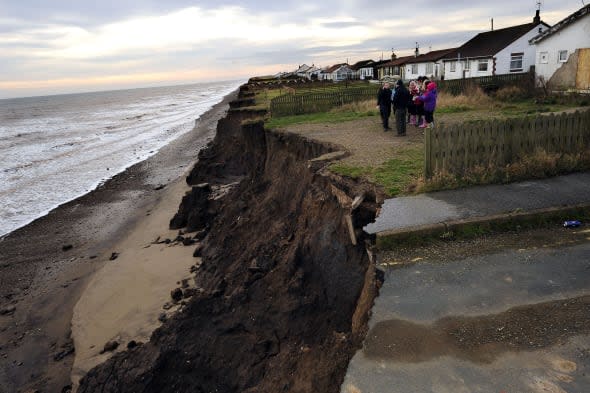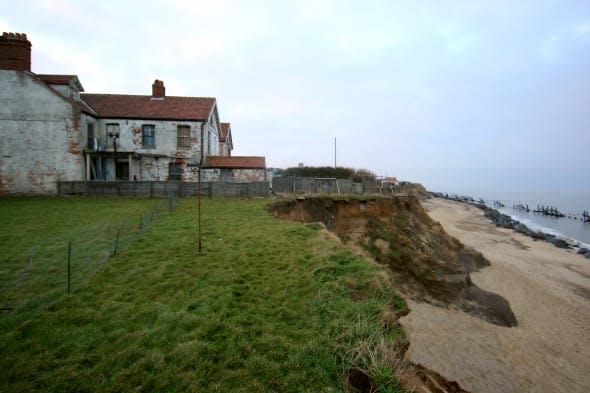British coastline is being destroyed, warns National Trust

A clear national strategy is "urgently needed" to help future-proof coastal areas from rising sea levels and extreme weather, according to a report published by the National Trust today.
The Trust, one of the UK's biggest coastal owners, says many of its sites have been "battered" by storms and "hit hard" by high tides this winter.
Birling Gap, part of the Seven Sisters chalk cliffs in East Sussex, experienced seven years of erosion this winter - leaving its cafe and shop teetering metres from the edge.
Part of the footpath down to the golden sands of Rhossili on Gower, South Wales - recently voted the UK's best beach - has been washed away by storms.
The charity says it has been forced to "fast-track" decisions over how to adapt coastal areas in the months ahead, rather than years or decades.

Simon Pryor, natural environment director at the National Trust, called for the Government to ensure strategies to future-proof the coastline are implemented.
"There is a natural inclination to want to defend the coastline with concrete, but our coastline is dynamic and the forces of nature that have formed it are part of its beauty," Dr Pryor said.
"Hard defences will always have their place, but the winter storms that hit many coastal places hard have provided a valuable reminder that they have a limited life.
"Where we can we need to give natural processes that have formed our coast the space to work, and create areas where the coastline can realign as the sea levels rise. Natural habitats such as sand-dunes and salt marshes can act as buffer zones that absorb the impact of storms and very high tides."
Dr Pryor said a report published by the Intergovernmental Panel on Climate Change reinforced the urgency of having a "workable plan" for long-term coastline management.
He said there was a "clear need" to reduce greenhouse gas emissions to avoid further accelerating climate change and the risk of more dramatic storm damage.
"Communities living on the coast, landowners, Government agencies and local and central Government all need to work together now to find solutions based around an adaptation approach to help future-proof the coastline," Dr Pryor added.
"Much of the framework to make this happen is in place but Government needs to act now to make sure that it's implemented and the support is there for coastal communities to begin planning to adapt."
The report, 'Shifting Shores - adapting to change', which is published today, highlights case studies of places affected by the storms.

Stretches of the wildlife-rich Norfolk coast at Brancaster and Blakeney Freshes saw significant changes as a result of a tidal surge in December.
Sand dunes at Murlough in Northern Ireland also suffered their worst erosion in living memory.
The Trust, which cares for 742 miles of coast in England, Wales and Northern Ireland, will have adaptation strategies in place for its 70 coastal places most at risk of erosion or flooding by 2020.
Around 60 per cent of the Trust's coastal land is at risk of erosion in the 21st century, with 15% of those sites potentially losing more than 100 metres of land to the sea.
Adaptation strategies for such areas will involve looking at future-proofing buildings on the coast, where car parks should be located, creating movable access to beaches and new habitats for wildlife.
Professor Andrew Cooper, professor of coastal studies at the University of Ulster, said: "The approach to coastal change management being adopted by the National Trust is exactly the type of adaptive approach that we will need to embrace as we face extremes of weather set against the backdrop of a changing climate and rising sea level.
"We cannot afford to, nor is it desirable, to try and engineer our way out of this."
A new project in Studland in Dorset, in partnership with Arts University Bournemouth, aims to create 'future-proof' beach huts that can withstand extreme weather and a changing coastline.
Some of the 270 beach huts at Studland have already had to be moved twice, with a number left "perilously" close to the beach after winter storms washed the footpath away.
Elli MacDonald, project manager at Studland, said: "Beach huts have been popular with families since Victorian times and are an important part of the special character of the British coastline. That's why we're trying to find a practical solution so that these symbols of the seaside can be enjoyed by generations to come."
The National Trust was founded in 1895, with its first acquisition a small area of coastal cliff about Barmouth in north Wales.
Last year, public support enabled the charity to acquire a one-mile stretch of the White Cliffs of Dover.





